Philip Liebson
Chicago, Illinois, United States
 |
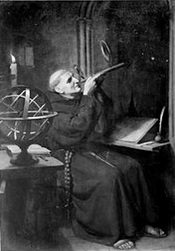 |
| |
|
The high Middle Ages in Europe were an era of witchcraft and sorcery. Flickering lights in marshes were ascribed to goblins or fairies, magic and superstition abounded. Astronomy and astrology were the noblest sciences, under God the geometer, who created the universe according to harmonic and geometric principles. Alchemy was the most popular applied science, being the search for the philosopher’s stone that would convert base metals into gold. During the Black Death of the mid- fourteenth century, the king called on the medical faculty at the University of Paris to determine the cause of the affliction. After a careful analysis of all presumed observations and theories, they decided it was due to a triple conjunction of Saturn, Jupiter, and Mars in a previous year.
Nonetheless it was a period considered by some medievalists as a time of early renaissance. This essay focuses on four medieval scholars who contributed greatly to the advance of scientific knowledge and lived between 1175 and 1347: Robert Grosseteste, Roger Bacon, Albertus Magnus, and William of Ockham. They contributed to rational inquiry, especially in astronomy, mathematics, the study of nature, and natural philosophy. It was also a time of resurgence of knowledge about early Greek science and philosophy, of the rediscovery of Aristotle from Arab sources, and of Arabic scientific theses. Emerging Universities, at Oxford, Cambridge, Paris, Montpellier, Padua, and Bologna, led to advances in medicine, Christian philosophy, and the method of scholasticism.
A that time scholasticism was central to university education. It was a method of learning, emphasizing dialectical reasoning to extend knowledge by inference and to resolve contradictions. Scholastic thought is also known for rigorous conceptual analysis and the careful drawing of distinctions. In the classroom and in writing, it often takes the form of explicit disputation; a topic drawn from the tradition is broached in the form of a question, opponents’ responses are given, a counterproposal is argued, and opponents’ arguments are rebutted. Because of its emphasis on rigorous dialectical method, scholasticism was eventually applied to many other fields of study.
As a program, scholasticism began as an attempt by medieval Christian thinkers to harmonize the various authorities of their own tradition and to reconcile Christian theology with classical and late antiquity philosophy, especially that of Aristotle but also of Neoplatonism.
The latter was influenced by the translations into Latin of Aristotle’s works, among others. The method emphasized empiricism, supported by secular study, reason, and logic. Its most famous proponent was Thomas Aquinas, who led the movement away from Platonism toward Aristotelian concepts of natural philosophy. This was the philosophical study of nature and the physical universe that was dominant before the development of modern science. It was the predecessor of biology, chemistry, and physics that emerged from the seventeenth century onward. The precursor of the modern scientific method can be attributed to the works of the four philosophers whom we will discuss.
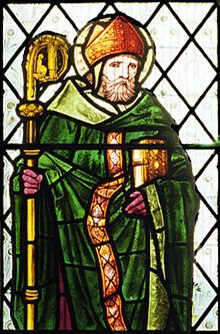 |
|
Robert Grosseteste (1175-1253) was an English statesman and scholastic philosopher who has been called the founder of the tradition of scientific thought at Oxford. He was a deacon in the diocese of Lincoln and eventually became archdeacon and bishop. While in his forties he began teaching theology at Oxford. Among his academic pursuits, he trained Franciscans in university theology. Roger Bacon, a Franciscan himself, was one of his disciples. His lecture topics included accounts of the Creation, the theological nature of truth, and Mosaic Law. However, he also expounded on elements of scientific method which influenced Bacon’s interest in scientific ideas – although the two might not have ever met.
His scientific works included texts on astronomy, on light and colors, on tidal movements, and on mathematical reasoning in science. Much of Grosseteste’s work on optics was similar to contemporary Arab investigations. He also wrote commentaries on Aristotle’s Physics and Posterior Analytics. His importance in science resides in the development of controlled experiments in deriving knowledge of the natural world. This included the development of universal laws from repeated observations, leading to the prediction of particular events from generalizations. This was derived from Aristotle’s scientific reasoning. He placed particular importance on mathematics as the basis of scientific discovery.
In cosmology, he considered that the universe began as an explosion leading to stars and planets being formed in condensations that could suggest galaxies. Grosseteste’s theory of knowledge in general, and of cosmology in particular, was based on what he called first form and first matter. In his metaphysical universe, light was intimately associated with matter. Light and matter, from a single point, initiated the multiplication of the universe. The cosmos became a system of nested celestial spheres because light diffuses spherically. These celestial spheres developed sequentially, concentrating matter from a higher sphere, the outer rim of the universe, into developing lower spheres, the lowest being the moon. Further concentration of matter that was incompletely dispersed led to progressively concentrated spheres of fire, air, water, and earth – the four elements. These classical four elements, unlike the celestial spheres, were capable of growth, change, and corruption.
His work on optics was of particular influence on Roger Bacon’s investigations and his thoughts on magnification would eventuate later to the development of telescopes. His theories of cosmology and optics were influential in Galileo’s investigations centuries later.
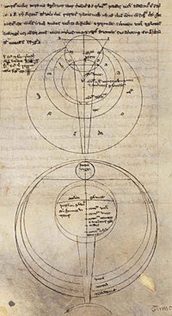 |
|
Roger Bacon (c.1219/1220-c.1292) was strongly influenced by Grosseteste’s work on optics and by his metaphysical philosophy. Bacon arrived at Oxford shortly after Grosseteste left, and there is some question the two ever met, although Bacon was thoroughly familiar with some of his texts. Bacon was a Franciscan friar like Grosseteste, who applied the empiricism of Grossteste to the study of nature. Like Grossetests he was also a scholastic. He revised the quadrivium ( mathematics, geometry, astronomy, music) in the university curriculum by the adding optics. Like Grosseteste, he was influenced by Aristotle and lectured on his philosophical and scientific ideas. As with Grossteste, he also lectured at the University of Paris, then the most prestigious university of the time, on the quadriuvium as well as Aristitelian logic and Latin grammar. He was a linguist and developed a universal greammar. At Paris with him was Albertus Magnus, whom we will discuss. He strived to apply Aristotelian logic and sciencre to theology in his Opus Majus, sent to the Pope.
The Opus Majus, his great work, dealt with alchemy, astronomy, mathematics, and optics. The work philosophically focused on human ignorance, the association of philosophy with theology, mathematics and phyics, experiemental knowledge, scientific perspective (optics), and morality. This was proposed to foster a revision of the university curriculum to include these subjects. Astronomy was to be taught with the inclusion of astrology and geography, concepts of mechanics, agriculture, alchemy, experimental science,philosophy of science, and medicine.
His study of optics included discussions on the anatomy of the eye, physiology of eyesight and the brain, and the use of lenses and mirrors in reflection and refraction of light.
He also wrote texts on the optical lens, alchemy and astrology, and even the first European descriptions of the contents and use of gunpowder, then coming into use from China. As with many of his contemporaries, European and Arabic, he considered alchemy (the word of course derived from Arabic) an important scientific subject.He developed alchemaic formulas, including one for a philosopher’s stone which presumably allowed transformation of base metals into gold. He discussed the composition and origins of metals, considering mercury and sulfur to be the source of other metals, an Arabic concept.
His considerations of calender reform may have influenced the later Gregorian calendar. He indicated that the ongoing Julian calendar should have called for the dropping of a day after several centuries to account for astronomical regularity, The Gregorian calendar later dropped one day in the first 300 of 400 years.
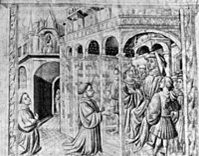 |
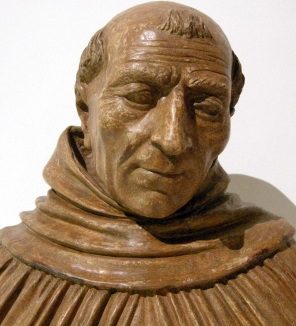 |
He was a man very much of his time, so in that in retrospect he was not considered a harbinger of the future. He distilled many of the leading new learning ideas of that period into focus, attempting to influence the Church to accept them.
Albertus Magnus (c.1193, 1200-c.1280), the only one of this foursome who was not English, was the son of a German lord. He joined the Dominican order and came into contact with Aristotle’s writings in the Latin translation while studying in Paris. One of his pupils at the University of Paris was Thomas Aquinas. He attempted to condense the entire body of knowledge of his work and to help familiarize his peers with it, including the subjects of natural science, physics, astronomy, logic, metaphysics, ethics, politics, mathematics, and rhetoric. This took about twenty years. He emphasized the importance of observation and reason in abstracting truth. Faith was also important to him, and the combination of faith and reason harmoniously led to the highest form of knowledge. His injection of Aristotelian thought into theology with his observations in the natural sciences influenced the development of scientific thought in that era.
Among the thinkers of this period who had a sense of what might be considered scientific discipline, the centrality of God was a ruling entity harmonizing matter and form. We see this in the thoughts of Grosseteste as well as of Bacon. Astronomy or astrology is central to this thesis, with a harmony of spheres circling the Earth. The influence of the spheres of the cosmos is central to astrology with their influence on earthly events in general and human experience in particular, thus the discipline of astrology and its importance to Albertus. The adaptation of celestial influence to Christian theology was central to him, improving those who analyze astrologic principles in their exercise of Christianity.
His knowledge of physical science was exceptional for the time, and his observations of nature provide, for example, essays on the habits of birds, variety of falcons, including care of sick and wounded falcons, and how to prepare them for the hunt.
His interest in experimentation and investigation led him to pursue the discipline of alchemy, as did so many of his contemporaries. This interest in alchemy led to investigations in chemistry and included the discovery of arsenic as a specific entity and work on photosensitive chemicals such as silver nitrate. He even recorded that he saw the transmutation of metals into gold.
His knowledge was so great that his contemporaries called him Albertus Universalis. He established the study of nature as a legitimate science within the Christian tradition. By papal decree in 1941, he was declared the patron saint of all who cultivate the natural sciences.
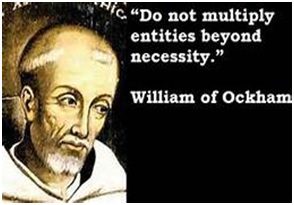 |
William of Ockham (c.1287-1347) was a master of logic, using it to allow selection among several undetermined theories (Ockham’s razor), a principle still used in modern science. He was a nominalist, believing that multiplicity of terms should not lead to multiplicity of entities or names. In other words, use the lowest common denominator for categorizing entities. Like the other theologians and philosophers of science discussed here, he joined a religious order, in his case the Franciscans. As with the other two English theologians, he studied at Oxford, philosophy and theology
In his great work, Summa Logicae, he discusses several principles of nominalism: 1. Statements about truths or conditions should be based either on self-evidence, evidence from individual experience, evidence from sacred scripture, or inducible logically from these; 2. Ockham’s Razor (vide supra); 3. Individual entities are singulars- thus “man” is a universal, not referring to a specific man, and therefore have no relevance in truth, contrary to the medieval uses of universals.
Opposition to his work by students and fellow friars led him to Avignon, where the Pope resided at the time, and where he was to be tried for heresy. Having then left Avignon without permission, he was excommunicated. Although fifty-one propositions in Ockham’s writing were censured by a papal commission, the Pope never formally condemned them.
Ockham died in 1347, possibly from the Black Death. This ended the period of great changes in the concepts of scientific philosophy because the population was markedly decreased by its ravages. During this period, many of Aristotle’s works were into Latin and used by these philosophers to counteract the neo-Platonic concepts of an immutable universe. Many of Aristotle’s concepts, and of the church’s as well, were challenged by the increasing application of observation and experimentation. Explanation by natural phenomena was increasingly substituted for divine intervention, mitigating the use of supernatural forces to explain unusual phenomena. Several works by contemporary philosophers led to theories that anticipated modern concepts of inertia, velocity and acceleration, and the laws of falling bodies well before Newton and Galileo. Nonetheless, the supernatural continued to be an important influence, as demonstrated by the dancing mania in a time when groups of people danced until exhausted because of presumed demonic presences.
Selected References
General
- Sarton, George (1948), Introduction to the History of Science, Vol. III: Science and Learning in the 14th Century, reprinted in 1975 by Robert E. Krieger Publishing, ISBN 978-0-88275-172-6
- Duhem Pierre, Pierre Essays on the History and Philosophy of Science (Ariew R and Barker P (trans.)) Indianapolis 1996
- Grant, Edward Foundations of Modern Science in the Middle Ages Cambridge 1996
- Grant, Edward God and Nature in the Middle Ages Cambridge 2001
- Huff, Toby The Rise of early Modern Science Cambridge 1995
- Lindberg, David C (ed.) Science in the Middle Ages Chicago 1978
- Tuchman, Barbara W. A Distant Mirror. The Calamitous 14th Century. Random House. 1978, 2014.
Robert Grosseteste
- Crombie, A. C. Robert Grosseteste and the Origins of Experimental Science. Oxford: Clarendon Press, 1971, OCLC 401196. ISBN 0-19-824189-5 (1953).
- Goering, J. W. & Mackie, E. A. (eds.), Editing Robert Grosseteste, Toronto: University of Toronto Press, 2003. ISBN 978-080-208-841-3
- McEvoy, James. The Philosophy of Robert Grosseteste. Oxford: Clarendon Press, 1992. ISBN 0-19-824645-5.
- McEvoy, James. Robert Grosseteste. Oxford: Oxford University Press, 2000.
- Southern, R. W. Robert Grosseteste: The Growth of an English Mind in Medieval Europe. Oxford: Clarendon Press, 1986. ISBN 0-19-820310-1 (Oxford University Press, USA; 2 edition (1 February 1992) pbk)
Roger Bacon
- Bacon, Roger (1983), Lindberg, David C., ed., Roger Bacon’s Philosophy of Nature: A Critical Edition, with English Translation, Introduction, and Notes, of “De Multiplicatione Specierum” and “De Speculis Comburentibus”, Oxford: Clarendon Press. (Latin) & (English)
- Bacon, Roger (1996), Lindberg, David C., ed., Roger Bacon and the Origins of Perspectiva in the Middle Ages: A Critical Edition and English Translation of Bacon’s Perspectiva with Introduction and Notes, Oxford: Clarendon Press, ISBN 0-19-823992-0 . (Latin) & (English)
- Bacon, Roger (2009), Maloney, Thomas S., ed., The Art and Science of Logic: A Translation of Roger Bacon’s Summulae Dialectices with Introduction and Notes, Mediaeval Sources in Translation, No. 47, Toronto: Pontifical Institute of Mediaeval Studies.
- Easton, Stewart C. (1952), Roger Bacon and His Search for a Universal Science: A Reconsideration of the Life and Work of Roger Bacon in the Light of His Own Stated Purpose, New York: Columbia University Press .
- Hackett, Jeremiah M.G. (1980), “The Attitude of Roger Bacon to the Scientia of Albertus Magnus”, Albertus Magnus and the Sciences: Commemorative Essays, Studies and Texts, Vol. 49, Toronto: Pontifical Institute of Mediaeval Studies, pp. 53–72, ISBN 0-88844-049-9
Albertus Magnus
- Weisheipl, James A. (1980), “The Life and Works of St. Albert the Great”, in Weisheipl, James A., Albertus Magnus and the Sciences: Commemorative Essays, Studies and texts, 49, Toronto: Pontifical Institute of Mediaeval Studies, p. 46, ISBN 0-88844-049-9
- Collins, David J. “Albertus, Magnus or Magus?: Magic, Natural Philosophy, and Religious Reform in the Late Middle Ages.” Renaissance Quarterly 63, no. 1 (2010): 1–44.
- Resnick, Irven (ed.), A Companion to Albert the Great: Theology, Philosophy, and the Sciences, Leiden, Brill, 2013.
- Resnick, Irven e Kitchell Jr, Kenneth (eds.), Albert the Great: A Selective Annotated Bibliography, (1900-2000) Tempe, Arizona Center for Medieval and Renaissance Studies, 2004.
William of Ockham
- Ockham’s Theory of Terms: Part I of the Summa logicae, translated by Michael J. Loux, (Notre Dame; London: University of Notre Dame Press, 1974) [translation of Summa logicae, part 1]
- Ockham’s Theory of Propositions: Part II of the Summa logicae, translated by Alfred J. Freddoso and Henry Schuurman, (Notre Dame: University of Notre Dame Press, 1980) [translation of Summa logicae, part 2]
- Demonstration and Scientific Knowledge in William of Ockham: a Translation of Summa logicae III-II, De syllogismo demonstrativo, and Selections from the Prologue to the Ordinatio, translated by John Lee Longeway, (Notre Dame, IN: University of Notre Dame, 2007)
- Ockham on Aristotle’s Physics: A Translation of Ockham’s Brevis Summa Libri Physicorum, translated by Julian Davies, (St. Bonaventure, NY: The Franciscan Institute, 1989)
- Adams, Marilyn (1987). William Ockham. Notre Dame: University of Notre Dame Press. ISBN 0-268-01940-1.
- Spade, Paul (1999). The Cambridge Companion to Ockham. Cambridge: Cambridge University Press. ISBN 0-521-58244-X.
PHILIP R. LIEBSON, MD, graduated from Columbia University and the State University of New York Downstate Medical Center. He received his cardiology training at Bellevue Hospital, New York and the New York Hospital Cornell Medical Center, where he also served as faculty for several years. A professor of medicine and preventive medicine, he has been on the faculty of Rush Medical College and Rush University Medical Center since 1972 and holds the McMullan-Eybel Chair of Excellence in Clinical Cardiology.

Leave a Reply